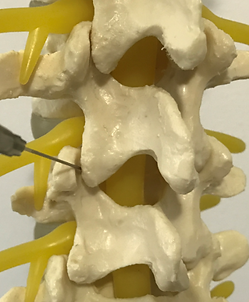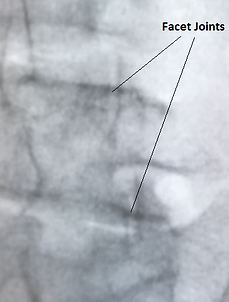FACET JOINT INJECTION
Facet joint injection or facet block is to inject anesthetic or anesthetic with steroid (cortisone) into the facet joint for either diagnostic purpose or therapeutic purpose. It can be done in a doctor’s office or in a hospital.
One of most common reasons for neck, mid-back and low back pain comes from facet joints. This pain is referred to as facet joint pain, facet jont pain syndrome, facet arthropathy, osteoarthritis, facet arthritis.
Facet joints are tiny small joints between every two vertebrae. There are two facet joints in each level. Facet joints are lining up from neck to the low back and it is located in the back of spine.
Please click here for more information about facet joint pain and treatment.

The facet joints are tiny small joints between every two vertebrae
Indications for Facet Joint Injection:
Facet joint injection is indicated for diagnostic and therapeutice injection for pain conditions in the spine.
Pain Conditions:
-
Low back pain
-
Neck pain
-
Mid-back pain
-
Post-laminectomy syndrome
-
Failed back surgery syndrome
-
History of spine fusion
-
Post-whiplash injury
Diagnositic Injection:
The purpose of this injection is to confirm if the pain indeed comes from facet joint. The pain in the neck and back can be very complicated and sometimes we are just not sure where the pain comes from even though we have all modern diagnostic tools. Local anesthetic agent injection can help us to sort it out if the pain comes from facet joints. This injection can be considered as confirmatory injection and it is the gold standard for diagnosing the facet pain syndrome currently.
Local anesthetics such as Marcaine (long-acting Lidocaine) is injected into facet joint and then to observe the patient to see if she or he has good pain relief for a period of time, or if she or he can aggravate his or her pain with painful activities. The result will guide the treating physician for the treatment subsequently.
There are three possibilities:
-
The pain is resolved completely. The pain comes from facet joint we injected solely. Treatment should focus on the facet joint.
-
The pain is reduced partially. The pain comes from the facet joint partially. If the patient has significant pain relief, we can continue to treat facet joint pain. However, there is other pain generator or source we may have to look for and treat.
-
The pain is unchanged at all. This means that the pain does not come from the facet joint we injected. The treating physician has to look for other source of the pain.
The treating physician will do diagnostic injection to confirm a clinical suspicion of the facet pain or/and to sort out which facet joint is actually involved due to possibility of pain from multiple joints. However, pure diagnostic injection is done less and less because we can do therapeutic injection to get both diagnostic information and therapeutic result.
Therapeutic Injection:
Diagnostic injection is solely for diagnostic purpose, but therapeutic injection can fulfill both diagnostic purpose and therapeutic purpose. It is because both local anesthetic (Marcaine) and steroid (cortisone) was injected into the facet joint together. Local anesthetic can serve diagnostic purpose as discussed above and below, and give patients a temporary pain relief and steroid can reduce inflammation, reduce swelling and then reduce the pain. The pain relief from therapeutic injection is from local anesthetic initially and then steroid will kick in in 1 to 3 days.
Contraindication:
-
Systemic infection
-
Skin infection over puncture site
-
Bleeding disorders or coagulopathy
-
Allergy to contrast agents or any of the medications to be administered
-
Pregnancy
Side Effects:
-
Pain can be worse for 1-3 days. However, it is tolerable for most of patients.
-
Contrast can reduce renal function and it should be cautious with the patients who has kidney disease.
-
Steroid can increase blood sugar and blood pressure. It should be cautious with the patient who has uncontrolled diabetis or high blood pressure.
-
There are risks of infection and bleeding whenever we break the skin. However, infection and bleeding is rare with facet joint injection.
Preparation for Procedure
The treating physician will review the patient medical record and discuss with the patient If the patient have following conditions:
-
Diabetes Mellitus: Steroid may increase level of blood sugar. It can be dangerous if the patient has uncontrolled diabetes.
-
High Blood Pressure: It can be problematic if the patient has uncontrolled high blood pressure.
-
Renal Disease: Contrast dye may aggravate the renal condition.
-
Allergy: It can be dangerous if the patient is allergic to contrast dye or any medications being used for the injection.
-
Pregnancy: X-Ray should not be used for women who are pregnant.
The patient should discuss medications with treating doctors, including prescription medications and over-the-county medications.
Blood thinner, thin the blood and increase risk of bleeding. It includes the medications below:
Anticoagulants:
-
Coumadin has to be stopped 5 days before the injection and check INR in the morning of the injection. INR has to be around 1.
-
Lovenox has to be stopped 24 hours before the injection.
-
Plavix, Pradaxa, Eliquis and Xarelto should also be stopped.
Anti-inflammatory medications (NSAID):
-
Ibuprofen, Motrin, Advil, Aleve, Naproxen, aspirin and so other anti-inflammatory medications should be stopped for 7 days before the injection.
Other Medications: the physician will review the patient's medication list before the injection. Some other medications may thin the blood except the medications mentioned above.
The patient should not eat or drink anything after midnight the night before theprocedure if the patient is going to have IV sedation. The patient may also need to consult with his or her physician to find out what other medications he or she can take or can’t take before the injection.
The patient does not have to stop eating or drink if he or she does not need IV sedation.
The physician may prescribe Valium for the patient if the patient is anxious and if the patient does not need IV sedation.
The patient needs a driver to drive him or her home after the procedure. The patient may need driver to drive him or her to the facility and home if the patient takes Valium or has IV sedation.
Procedure:
The procedure can be performed in a doctor's office or in the hospital. The injection itself may only take about 5 minuts. However, the entire procedure may last 20-30 minutes.
The treating physician may review the patient's case again with the patient and answer questions before the procedure. The patient should always mention his or her allergy or allergies to the treating physician before the procedure. The patient is going to sign consent form first.
The injection is performed without any sedation. However, some patients may need Valium before the injection.
The patient is brought to the procedure room and placed in the prone position (face down) in a surgical table.
The treatment area is disinfected with Beta-dine three times.
A X-Ray machine (fluoroscope) is used to locate facet joints.
Local anesthetic agent is used to numb the injection sites with a very fine needle. The patients may feel some discomfort with transient burning sensation.
Spinal needles are then inserted under the guidance of real-time fluoroscope.
The needle is placed into the facet joint. Contrast dye is injected into the joint to confirm the needle position.
Medications, local anesthetic agent, or mixture of local anesthetic agent with steroid (cortisone) are injected into the joint(s).
The needles are withdrawn and puncture areas are dressed with a Band-Aid.
The patient will be observed for about 20 minutes after the procedure.

Picture shows a needle inside facet joint.

X-Ray image shows facet Joints.
Post Procedure Care
-
The patient should not drive on the day of the injection unless approved by the treating physician.
-
If sedation was used, the patient should not drive for 24 hours after the procedure.
-
The patient should follow up with treating physician in 2 weeks to plan further treatment according to the effectiveness of the injection.
-
The patient should have pain dairy, i.e. write down the pain level before the injection and every hour for 6 hours after the injection. This will help the treating physician to find out if the injection has any effect on the patient and planning future tests and treatment. This is especially critical for the patient who has diagnostic injection because it will tell the treating physician if the pain is generated in the injected joint. There are several possibilities:
-
There is significant pain relief for the first 4-6 hours: It confirms that facet joint is the pain generator.
-
For diagnostic injection, the patient may proceed with surgery or radiofrequency.
-
For therapeutic injection, the patient may proceed with surgery or radiofrequency if the patient does not have significant pain relief in 2-3 weeks.
-
-
There is no significant pain relief for the first 4-6 hours: The pain does not come from facet joint. Other source of pain should be searched.
-
-
The patient may hold pain medicine within the first six hours after the injection.
-
The patient may remove Band-Aid or other dressing in 6 hours and may take shower at the night.
-
The pain may be worse in a few hours after injection and it can last 1 to 3 days. Then the pain should get better gradually. The initial pain relief is due to local anesthetic and the pain relief later on is due to steroid effect.
-
If the injection site is uncomfortable after the injection, the patient may apply cold pack to reduce the pain for the first 48 hours.
-
The patient may resume regular activities after the injection. However, the patient should avoid doing any strenuous activities. The patient should get advice from the treating physician when to start regular exercise and what precaution should be followed.
-
If the patient has sign of infection, such as fever, chills, or redness or drainage at the treatment site or has temperature of 101 degrees or greater, He or she should call his or her treating physicial office or go to emergency room if the treating physician is not available.
-
The Patient may be referred back for more physical therapy, acupuncture treatment or other conservative management after the injection. The combination of facet joint injection with physical therapy, acupuncture or other conservative management may achieve better result.
Potential Risks and Complications
- The potential risks and complications are very low and complications are rare.
-
Related to needle:
-
Bleeding.
-
Infection
-
-
Nerve or spinal cord damage. Those are very rare complications.
-
Related to Medications
-
Allergic to contrast, steroid, local anesthetic agent.
-
As general rule, patients should always mention their allergy to treating physician before any procedures.
-
-
Side effect due to steroid:
-
-
Transient hot flashes
-
Fluid retention
-
Weight gain
-
increased appetite
-
Elevated blood pressure
-
Mood swings, irritability, anxiety, insomnia
-
High blood sugar - diabetic patients should inform their primary care physicians about the injection prior to their appointment
-
Steroid psychosis
-
Fortunately, those side effects from steroid only last 1-3 days in general.
-
-
-
